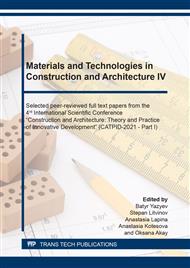p.1
p.9
p.15
p.27
p.37
p.43
p.49
p.55
On the Issue of Standardizing Concrete Frost Resistance to Ensure the Reinforced Concrete Structures Durability
Abstract:
When erecting monolithic reinforced concrete structures, the structure of concrete can differ significantly from the laboratory standard due to the complexity of providing favorable conditions for hardening, and therefore the compressive strength and especially the frost resistance of concrete may not meet the design requirements, which can negatively affect the reinforced concrete structure durability and require amplification, especially in earthquake-prone areas [1, 2]. Increasing the durability of reinforced concrete structures is possible by creating a rational stress field, for example, by prestressing, incl. variable along the length of the structure [3,4], but this technique is difficult to implement for monolithic reinforced concrete structures. It is possible to use effective materials or methods of manufacturing structures [5, 6]. But this is also mainly problematic for use in the construction of monolithic reinforced concrete structures. Generally accepted methods of calculating the reinforced concrete structures durability subjected to cyclic freezing-thawing during operation, incl. in a water-saturated state, do not exist. At the design stage, ensuring the durability of such reinforced concrete structures is mainly reduced to the reasonable assignment of requirements for concrete quality indicators, depending on the operating conditions, which is the focus of BC 28.13330.2017 (EN 206) and GOST 31384-2017 from the premise of ensuring durability of at least 50 years. In the above-mentioned norms of the Russian Federation, in fact, two approaches are presented to ensure the durability of reinforced concrete structures during cyclic freezing-thawing, incl. in a water-saturated state, namely: designing a concrete structure capable of working under such conditions by standardizing the values of cement consumption, W/C ratio, class of concrete in terms of compressive strength, amount of entrained air, or rationing of concrete grades in terms of frost resistance F1 (first base method GOST 10060-2012 provides for freezing in air, saturation and thawing in water) or F2 (second base method GOST 10060-2012 provides for freezing in air, saturation and thawing in 5% sodium chloride solution). The purpose of this work is to compare various approaches to ensuring the durability of reinforced concrete structures operated during cyclic freezing-thawing and to analyze the provision of durability with standardized indicators when designing the structure of concrete.
Info:
Periodical:
Pages:
1-7
Citation:
Online since:
August 2021
Price:
Сopyright:
© 2021 Trans Tech Publications Ltd. All Rights Reserved
Share:
Citation:


